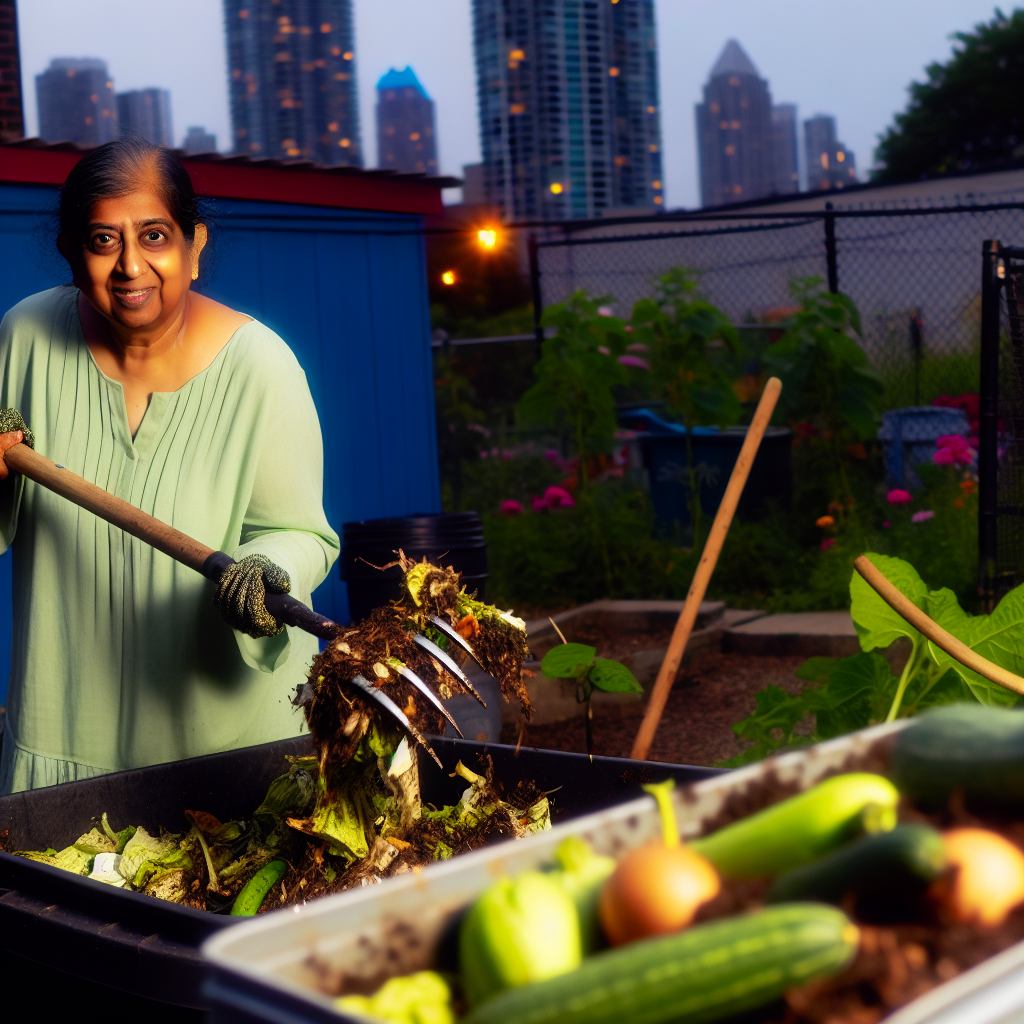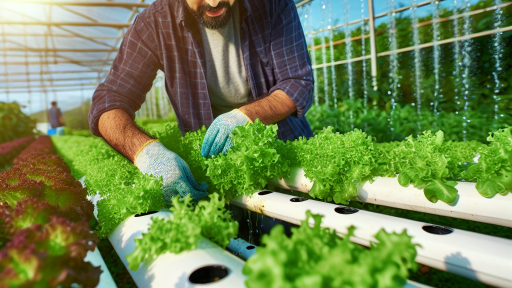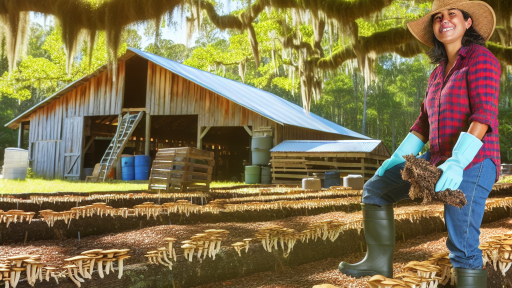Introduction to Composting: Importance for City Farms
Composting plays a crucial role in sustainable urban agriculture.
It transforms organic waste into nutrient-rich soil amendments.
This process helps reduce landfill waste significantly.
Furthermore, it enhances soil health and fertility.
City farms greatly benefit from composting practices.
These techniques allow farmers to produce healthy crops.
Additionally, composting reduces the need for chemical fertilizers.
Overall, it contributes to a healthier environment.
Benefits of Composting for Urban Agriculture
Composting improves soil structure and moisture retention.
This leads to better crop yields and resilience.
Moreover, it encourages beneficial microbial activity in the soil.
This microbial diversity supports plant health.
Additionally, composting reduces urban heat islands.
It also helps in carbon sequestration efforts.
By recycling organic matter, cities can lower their carbon footprint.
Transform Your Agribusiness
Unlock your farm's potential with expert advice tailored to your needs. Get actionable steps that drive real results.
Get StartedEncouraging Community Involvement
Composting encourages community participation in sustainability efforts.
Residents can contribute their kitchen scraps to local farms.
This fosters a sense of shared responsibility for the environment.
Moreover, educational programs can teach residents about composting.
These initiatives can include workshops and demonstrations.
As a result, communities can work together towards greener practices.
Types of Composting Techniques: An Overview
Traditional Composting
Traditional composting is a natural process of decomposition.
This technique involves creating a compost pile outdoors.
It requires a mix of green and brown materials.
Examples of green materials include food scraps and grass clippings.
Brown materials can be dried leaves and cardboard.
Over time, microorganisms break down these materials.
This process results in nutrient-rich compost.
Tumbler Composting
Tumbler composting utilizes a closed drum system.
This method allows for easy mixing of compost materials.
Users can turn the tumbler regularly to aerate the compost.
The enclosed environment speeds up decomposition.
This technique is ideal for small spaces.
However, it requires regular monitoring of moisture levels.
Bokashi Composting
Bokashi composting is an anaerobic fermentation process.
This method uses a special mix of effective microorganisms.
Individuals can compost all food waste, including meat and dairy.
The process occurs in a sealed container.
After fermentation, the partially decomposed waste can enter the soil.
Showcase Your Farming Business
Publish your professional farming services profile on our blog for a one-time fee of $200 and reach a dedicated audience of farmers and agribusiness owners.
Publish Your ProfileThis technique enriches the soil while minimizing odors.
Vermicomposting
Vermicomposting employs red worms to break down organic waste.
This method works well indoors and outdoors.
Worms convert kitchen scraps into high-quality compost.
This process is quick, producing compost in a matter of weeks.
Additionally, vermicomposting reduces landfill waste.
It also contributes valuable nutrients back to the soil.
Lasagna Composting
Lasagna composting layers materials like a lasagna.
This technique uses alternating layers of browns and greens.
It creates a productive compost pile without turning it.
The layers decompose over time, enhancing soil health.
The method works best in garden beds or large bins.
Moreover, it helps suppress weeds while enriching the soil.
Multi-bin Composting
Multi-bin composting involves using several bins for composting.
This method allows for different stages of decomposition.
As materials in one bin decompose, the next bin can be filled.
This technique ensures continuous compost production.
Additionally, it helps manage different types of organic waste.
Effective use requires planning and monitoring of the bins.
Bokashi Composting: Benefits and Step-by-Step Process
Understanding Bokashi Composting
Bokashi composting is an anaerobic fermentation method.
This method effectively breaks down organic waste, including meat and dairy.
Moreover, it requires less space than traditional composting techniques.
Benefits of Bokashi Composting
Bokashi composting offers multiple benefits for urban agriculture.
First, it reduces kitchen waste significantly.
This method accelerates decomposition processes.
Furthermore, Bokashi composting produces nutrient-rich soil amendments.
Additionally, it eliminates unpleasant odors commonly associated with composting.
Gather Necessary Materials
Start by collecting essential materials for Bokashi composting.
You will need a Bokashi bin, which is airtight.
Also, gather Bokashi bran, which contains microorganisms.
Finally, keep a supply of food scraps handy for the process.
Step-by-Step Bokashi Process
Begin the Bokashi process by layering food scraps in the bin.
Sprinkle Bokashi bran on top of each layer of scraps.
Ensure you compact the scraps to eliminate air pockets.
Close the lid tightly after each addition to maintain anaerobic conditions.
Fermentation Duration
Allow the mixture to ferment for approximately two weeks.
The fermentation process creates a unique smell, similar to pickles.
Occasionally, you can drain the liquid using the bin’s spigot.
This “Bokashi tea” is a great fertilizer for plants and gardens.
Final Steps for Use
After two weeks, transfer the fermented material to the soil.
Showcase Your Farming Business
Publish your professional farming services profile on our blog for a one-time fee of $200 and reach a dedicated audience of farmers and agribusiness owners.
Publish Your ProfileYou can bury it in a garden bed or potting mix.
Cover the material with soil to complete the process.
This allows it to fully break down over a few weeks.
Maintaining Your Bokashi System
Regularly check your Bokashi bin for moisture levels.
Moisture helps maintain fermentation but can also create odor issues.
Adjust the amount of Bokashi bran as necessary.
This ensures effective anaerobic decomposition and successful results.
You Might Also Like: Benefits of Heirloom Seeds for Sustainable Farming
Vermicomposting: Using Worms to Enhance Compost Quality
Introduction to Vermicomposting
Vermicomposting transforms organic waste into nutrient-rich compost.
This process utilizes worms, specifically red wigglers.
These worms break down kitchen scraps and yard waste efficiently.
As a result, gardeners gain high-quality compost for their plants.
Benefits of Vermicomposting
Vermicomposting provides a range of benefits for urban farms.
It creates less odor compared to traditional composting methods.
Additionally, it occupies minimal space, making it ideal for cities.
Moreover, it enriches the soil with essential nutrients and microorganisms.
This method also helps sequester carbon, contributing to climate control.
Setting Up a Vermicomposting System
Creating a vermicomposting system is simple and accessible.
First, choose a suitable container, such as a bin or tote.
Drill holes for aeration and drainage, ensuring proper airflow.
Next, prepare bedding using shredded newspaper or cardboard.
Moisten the bedding to create a healthy habitat for the worms.
Choosing the Right Worms
Selecting the right type of worm is crucial for successful vermicomposting.
Red wigglers, or Eisenia fetida, are the best choice for composting.
These worms thrive in decomposing organic material.
They reproduce quickly, creating a sustainable composting system.
Feeding Your Worms
Feeding your worms requires some care and attention.
Include kitchen scraps like fruit peels, vegetable trimmings, and coffee grounds.
Avoid adding meat, dairy, and oily foods to prevent odors.
Chop food into small pieces to speed up decomposition.
Maintaining the Vermicomposting System
Regular maintenance ensures a thriving worm population.
Monitor moisture levels in the bin, keeping it damp but not soggy.
Stir the compost occasionally to maintain airflow and even distribution.
Remove excess food if it begins to rot or attract pests.
Harvesting Your Compost
Harvesting compost occurs approximately every few months.
To do so, move worms to one side of the bin.
Add fresh bedding to the empty side and feed the worms there.
After a week or two, the compost can be removed easily.
This nutrient-dense compost is ready for application in gardens.
Utilizing Vermicompost in Your Garden
Applying vermicompost enriches plants and enhances growth.
Showcase Your Farming Business
Publish your professional farming services profile on our blog for a one-time fee of $200 and reach a dedicated audience of farmers and agribusiness owners.
Publish Your ProfileUse it as a top-dressing for existing plants or mix it into new soil.
Vermicompost can improve soil structure, enhancing drainage and aeration.
Furthermore, it helps retain moisture, reducing the need for watering.
Learn More: Preserving Heritage Varieties on Your Farm
Hot Composting: Procedures and Temperature Control
Understanding Hot Composting
Hot composting involves managing organic waste to create nutrient-rich compost.
This method relies on high temperatures to accelerate decomposition.
By maintaining an ideal temperature, you can enhance the breakdown of materials.
Preparing Materials
Start by gathering a mix of green and brown materials.
Green materials are high in nitrogen, such as kitchen scraps.
Brown materials are high in carbon, like dry leaves and cardboard.
Balancing these materials is crucial for effective composting.
Building Your Compost Pile
Choose a suitable location for your compost pile.
A well-draining area is essential for efficient composting.
Layer the materials, starting with coarse items at the bottom.
This promotes airflow and prevents compaction.
Temperature Control
Monitor the temperature of your compost pile regularly.
The ideal temperature range for hot composting is between 130°F and 160°F.
To maintain this range, turn the pile every few days.
Turning aerates the compost and ensures even decomposition.
Moisture Management
Keeping the compost pile moist is vital for microbial activity.
Aim for a moisture level similar to a wrung-out sponge.
If the pile is too dry, sprinkle water over it to rehydrate.
If it’s too wet, add more brown materials to balance it out.
Harvesting Compost
Your compost will be ready when it reaches a dark, crumbly consistency.
It usually takes three to six months for hot composting to complete.
Once ready, sift through the compost to remove any large chunks.
This nutrient-dense compost can enhance soil health in urban gardens.
Gain More Insights: Setting Up Your First Aquaponic System
Cold Composting: A Low-Maintenance Approach
Overview of Cold Composting
Cold composting is an easy and effective composting method.
This technique requires minimal effort and maintenance.
Gardeners appreciate its low-impact nature.
It is suitable for urban environments with limited space.
Key Characteristics
Cold composting operates at ambient temperatures.
This process takes longer than hot composting systems.
However, it is less labor-intensive.
Organic materials decompose naturally over time.
Benefits of Cold Composting
- It requires less frequent turning of materials.
- Cold composting prevents nutrient loss from excessive heat.
- This method supports healthy soil microbiomes.
- It reduces odors since decomposition is slower.
Materials Suitable for Cold Composting
Choose a mix of green and brown materials for balance.
Green materials include grass clippings and vegetable scraps.
Brown materials could be dried leaves and shredded paper.
Avoid adding meat, dairy, and oils to your pile.
Showcase Your Farming Business
Publish your professional farming services profile on our blog for a one-time fee of $200 and reach a dedicated audience of farmers and agribusiness owners.
Publish Your ProfileSetting Up Your Cold Compost
Start by choosing a designated composting area.
Use a compost bin or simply pile materials in a corner.
Layer green and brown materials in your pile.
Keep the pile moist but not soggy.
Managing Your Cold Compost
Do not worry about frequent turning.
Instead, let nature take its course.
Monitor moisture levels to ensure optimal decomposition.
After several months, you will notice the breakdown of materials.
Your compost will be ready when it resembles dark, crumbly soil.
Using Your Finished Compost
Incorporate your cold compost into garden beds or containers.
This rich, organic material enhances soil health.
It provides essential nutrients for plants.
Regular use improves moisture retention in the soil.
Explore Further: Best Plants for Hydroponic Systems

Composting with Kitchen Scraps: Best Practices and Creative Ideas
Understanding Kitchen Scraps
Kitchen scraps are organic materials left over after food preparation.
These scraps include fruit and vegetable peels, eggshells, and coffee grounds.
Each of these components contributes valuable nutrients to compost.
Benefits of Composting Kitchen Scraps
Composting kitchen scraps reduces waste in landfills.
It also enriches soil and promotes healthy plant growth.
In addition, composting can lower greenhouse gas emissions.
Best Practices for Composting Kitchen Scraps
First, collect your kitchen scraps in a compost bin.
Ensure you balance green materials with brown ones.
Green materials include scraps, while brown materials include leaves or cardboard.
Next, chop up larger pieces to speed up decomposition.
Maintain moisture levels; the compost should feel like a damp sponge.
Finally, turn your compost regularly to aerate it.
Creative Ideas for Using Kitchen Scraps
Repurpose vegetable scraps by creating vegetable broth.
Save citrus peels for natural cleaners or pest repellents.
You can also use eggshells as a natural fertilizer in gardens.
Consider making compost tea by soaking compost in water.
This nutrient-rich liquid can feed your plants effectively.
Common Mistakes to Avoid
Avoid adding meat, dairy, or oily foods to your compost.
These items can attract pests and create odor issues.
Do not neglect to turn the compost; it needs aeration to break down.
Lastly, avoid adding diseased plants, which can contaminate the compost.
Start Composting Kitchen Scraps Today
Starting a composting system with kitchen scraps is both easy and rewarding.
By following these best practices, you can create rich soil for your urban garden.
Moreover, you contribute positively to the environment while reducing waste.
Utilizing Composting Bins
Choosing the Right Equipment for City Spaces
City farms face unique challenges when composting.
Utilizing composting bins can solve many of these challenges.
Showcase Your Farming Business
Publish your professional farming services profile on our blog for a one-time fee of $200 and reach a dedicated audience of farmers and agribusiness owners.
Publish Your ProfileBy choosing the right equipment, urban gardeners can optimize space.
Various types of composting bins cater to different needs.
Types of Composting Bins
First, consider traditional compost bins.
These bins are perfect for larger spaces.
They allow for significant material accumulation.
Next, think about tumblers.
They speed up the composting process significantly.
Tumblers are ideal for smaller urban gardens.
Additionally, worm bins offer a compact solution.
They are suitable for apartments and small spaces.
Worm bins require minimal maintenance.
Selecting the Right Size
Choosing the right size of the compost bin is crucial.
A smaller bin suits a single household.
Larger bins benefit community gardens.
Estimate the amount of waste generated weekly.
This estimate helps determine bin size.
Material Considerations
Composting bins come in various materials.
Plastic bins provide affordability and lightweight options.
Wooden bins offer durability and natural aesthetics.
Metal bins are also available, but they can be more expensive.
Evaluate the local climate when choosing materials.
Essential Features to Look For
Look for ventilation features in your compost bin.
Good airflow accelerates the composting process.
Ensure that your bin has proper access points.
Ease of use boosts the chances of regular composting.
Lastly, consider whether the bin is odor-proof.
An odor-proof bin minimizes disruption in city environments.
Troubleshooting Common Composting Problems in Urban Environments
Identifying Odors
Unpleasant smells may indicate issues with your compost pile.
First, check the balance of greens and browns.
A pile too rich in nitrogen often emits odors.
Additionally, poor aeration can cause anaerobic conditions.
Tossing your compost can introduce oxygen and reduce smells.
Furthermore, adding carbon-rich materials helps absorb excess moisture.
Managing Pests
Pests can become a nuisance in urban composting.
To deter them, avoid adding meat or dairy products.
Sealing your compost bin can also minimize access for critters.
Moreover, regularly turning the compost can disrupt pest habitats.
Consider using compost bins with a secure lid.
Addressing Composting Speed
Slow decomposition can frustrate urban gardeners.
Ensure a proper balance of materials in your compost pile.
Showcase Your Farming Business
Publish your professional farming services profile on our blog for a one-time fee of $200 and reach a dedicated audience of farmers and agribusiness owners.
Publish Your ProfileInadequate moisture can also slow down the process.
Make sure the pile is damp but not waterlogged.
Frequent turning will help introduce air and increase speed.
Preventing Low Temperature
Cold compost piles fail to reach optimal temperatures.
This can hinder the breakdown of materials significantly.
Consider adding more green materials to boost heat production.
Larger piles retain heat better, so aim for a sizable compost heap.
Additionally, insulating the compost bin with straw bales can help.
Correcting High Moisture Levels
Excessive moisture creates issues in urban composting.
Use dry materials to soak up moisture when needed.
Incorporate cardboard or shredded paper if the pile is too wet.
Furthermore, ensure proper drainage in your compost bin.
Regularly mixing the pile promotes better moisture distribution.
The Role of Compost in Urban Agriculture
Enhancing Soil Health
Compost plays a vital role in enhancing soil health in urban farms.
It enriches the soil with essential nutrients and improves its structure.
This leads to better water retention and drainage in the soil.
Consequently, plants grown in compost-enhanced soil thrive more effectively.
Promoting Microbial Life
Compost boosts microbial activity in the soil ecosystem.
This microbial life is crucial for breaking down organic matter.
As a result, beneficial nutrients become accessible to plants.
Healthy microbial populations also help suppress plant diseases.
Reducing Waste in Urban Environments
Using compost helps minimize organic waste in landfills.
Many city farms are creating compost from kitchen scraps and yard waste.
This practice not only reduces waste but also produces valuable compost.
Urban farms can transform waste into a resource, enhancing sustainability.
Improving Crop Yields
Research shows that compost can significantly increase crop yields.
Urban farmers observe better growth and higher produce quality.
Moreover, consistent use of compost leads to healthier, more resilient crops.
Enhanced crop yields contribute to food security in urban areas.
Establishing Sustainable Practices
Incorporating composting into urban agriculture supports sustainability.
This practice reduces reliance on chemical fertilizers and pesticides.
Urban farms adopting composting contribute positively to the environment.
They promote a circular economy, where waste is reused effectively.




